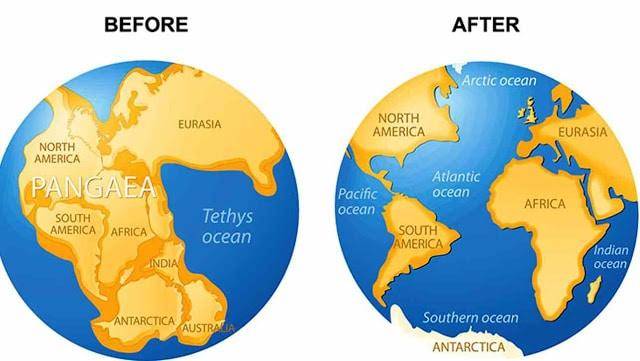Is Pangaea The Supercontinent coming back?
We have studied in geography back in school days that there are 8 planets, the earth is the third nearest planet to SUN, and our EARTH is divided into many continents like Asia, Antarctica, Australia or Oceania, Europe, South America, North America, and Africa. I assume everyone taking a glance at this piece of article is aware of these continents, BUT have you wondered what a supercontinent is or heard about a supercontinent? People who have a great fascination for Earth and the environment might be aware of what is it. But for all those who are still wondering and creating their hypothesis somewhere in the back of their mind let me tell you what it is…
[media-credit name=”http://www.geologyin.com” link=”http://www.geologyin.com” align=”alignnone” width=”640″] [/media-credit]
[/media-credit]
A Supercontinent is a grouping of all the continents to form a single landmass. This landmass is the largest in an area with varied vegetation. A supercontinent existed millions of years ago when you and I had no traces of existence, nature is immensely mysterious and enchanting at the same time. It creates situations so perplexing that even the greatest of scientists and philosophers cannot come up with any explanation or answers for it’s changing phenomenon. It takes years to solve a single puzzle, yet there is a tandem mystery waiting for us.
Talking about the supercontinent, there existed many supercontinents looking at the geologic history such as Rodinia, Columbia or Nuna, Pannotia, etc. Pangaea is the only ancient supercontinent that comprised almost all the landmass on earth millions of years ago. The name Pangaea arises from the Greek word Pangaea which meant “all the Earth”. It took unimaginable years for all the landmass to come together, and again it tattered into pieces and formed various continents due to continental shift.
Like today all the continents are surrounded by various oceans like the Indian Ocean, Pacific Ocean, etc., Pangaea was surrounded by Panthalassa (around 290 to 270 million years ago) and was intact in the Early Permian Epoch. Pangaea started to break into subcontinents around 200 million years ago, during the early Jurassic Epoch. Scientists have given various approaches for Pangaea to shift and tatter into subcontinents like Continent drift and plate tectonics.
Plate tectonic explanation or theory is widely accepted. This describes that lithosphere or outer shell of earth comprises of large rigid plates that move apart at ocean ridges, and comes together at a subduction zone. The plates also sometimes slip past each other along the fault lines. Plate tectonic postulates that scattering of continent happened a lot of times and not only once.
Talking about the oceans, the first ocean that came into prominence as the central Atlantic Ocean and Indian ocean. 80 million years ago India broke away from Madagascar and collided with Eurasia around 50 million years ago forming the Himalayas.
The new research was submitted and presented at the annual meeting of the American Geophysical union highlights. The future of our continents suggests a unity the same as Pangaea. Scientists have predicted that 200 to 250 million years from now, the continents will come together to form a supercontinent. Can you imagine how would that appear?
It is assumed that the supercontinent will be formed around the equator. Researchers of NASA have used plate tectonics, solar luminosity, and rotation rate model to explain how this will occur and the two supercontinents in the future are named Amasia and Aurica by researchers. In the case of Amasia, the continent surrounding the North pole except Antarctica, will face a much colder temperature covered with ice throughout the year. The sea level around this landmass will also be lower as most of the water will freeze. This can be explained due to the absence of land the ocean currents will be disturbed and heat will move from the equator towards the poles.
In the case of the Aurica supercontinent, there would be an opposite scenario of Amasia. More landmass will be present around the equator which will lead to the absorption of more and more heat, making the temperature rise. Another reason for the temperature rise will be the absence of polar ice caps. In the end, the planet would end up being 3 degrees Celsius hotter than the current.
The difference in temp. and climate in these two supercontinents Aurica and Amasia are drastic and varied. The researchers conclude that using a simple aqua planet or modern earth land/sea masks is not enough to explore the possible variance in theories of extrasolar planetary atmospheres.
Whatever we are seeing through our eyes today took billion of years to build, even a stone or particle of sand takes thousand of years to come into this shape. It’s immensely difficult to say what may happen millions of years later, but not impossible to predict I must say.

